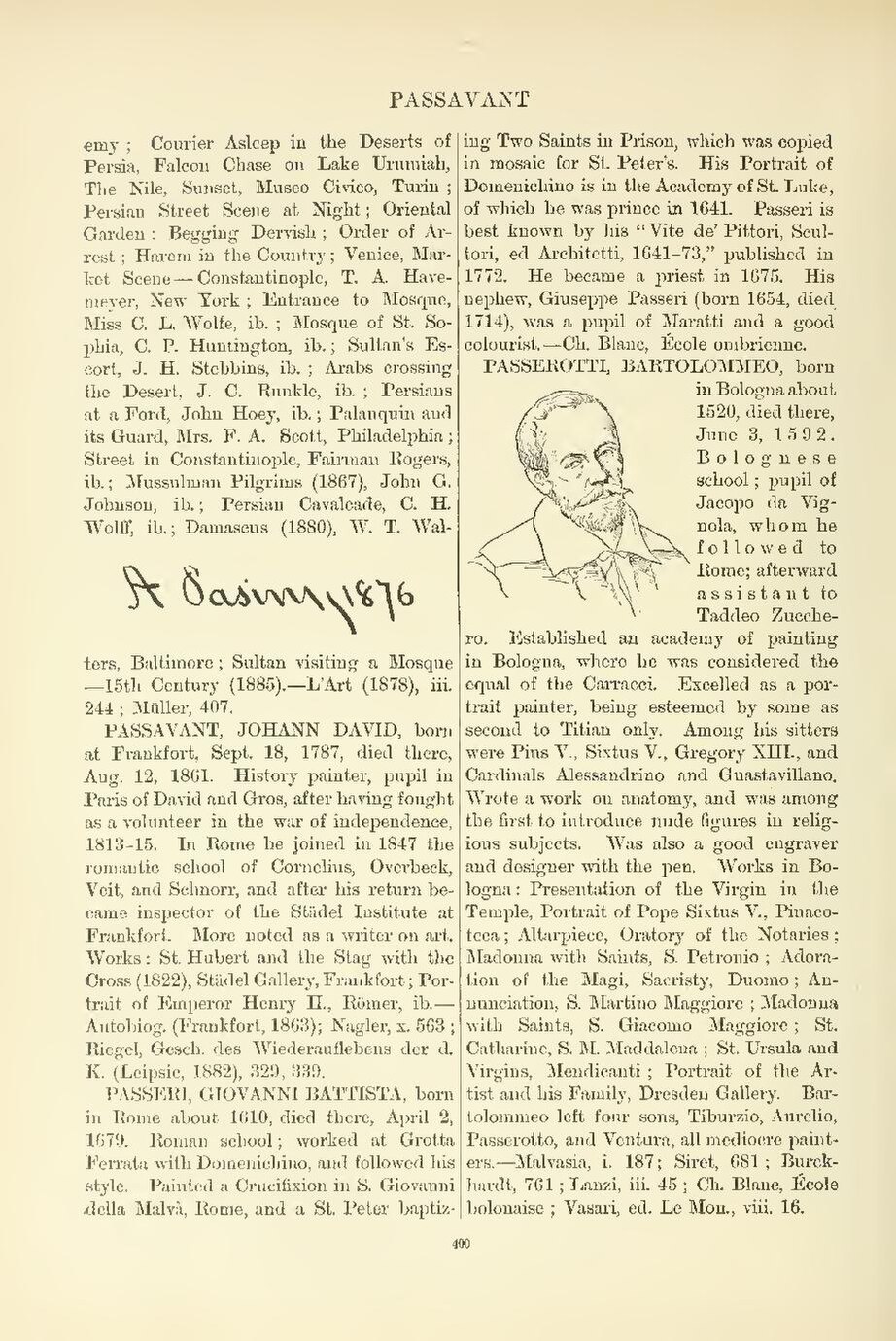- emy; Courier Asleep in the Deserts of
Persia, Falcon Chase on Lake Urumiah, The Nile, Sunset, Museo Civico, Turin; Persian Street Scene at Night; Oriental Garden; Begging Dervish; Order of Arrest; Harem in the Country; Venice, Market Scene—Constantinople, T. A. Havemeyer, New York; Entrance to Mosque, Miss C. L. Wolfe, ib.; Mosque of St. Sophia, C. P. Huntington, ib.; Sultan's Escort, J. H. Stebbins, ib.; Arabs crossing the Desert, J. C. Runkle, ib.; Persians at a Ford, John Hoey, ib.; Palanquin and its Guard, Mrs. F. A. Scott, Philadelphia; Street in Constantinople, Fairman Rogers, ib.; Mussulman Pilgrims (1867), John G. Johnson, ib.; Persian Cavalcade, C. H. Wolff, ib.; Damascus (1880), W. T. Walters, Baltimore; Sultan visiting a Mosque—15th Century (1885).—L'Art (1878), iii. 244; Müller, 407.
An image should appear at this position in the text. To use the entire page scan as a placeholder, edit this page and replace "{{missing image}}" with "{{raw image|Cyclopedia of painters and paintings (IA cyclopediaofpain03cham).pdf/422}}". Otherwise, if you are able to provide the image then please do so. For guidance, see Wikisource:Image guidelines and Help:Adding images. |
PASSAVANT, JOHANN DAVID, born at Frankfort, Sept. 18, 1787, died there, Aug. 12, 1861. History painter, pupil in Paris of David and Gros, after having fought as a volunteer in the war of independence, 1813-15. In Rome he joined in 1847 the romantic school of Cornelius, Overbeck, Veit, and Schnorr, and after his return became inspector of the Städel Institute at Frankfort. More noted as a writer on art. Works: St. Hubert and the Stag with the Cross (1822), Städel Gallery, Frankfort; Portrait of Emperor Henry II., Römer, ib.—Autobiog. (Frankfort, 1863); Nagler, x. 563; Riegel, Gesch. des Wiederauflebens der d. K. (Leipsic, 1882), 329, 339.
PASSERI, GIOVANNI BATTISTA, born
in Rome about 1610, died there, April 2,
1679. Roman school; worked at Grotta
Ferrata with Domenichino, and followed his
style. Painted a Crucifixion in S. Giovanni
della Malvà, Rome, and a St. Peter baptizing
Two Saints in Prison, which was copied
in mosaic for St. Peter's. His Portrait of
Domenichino is in the Academy of St. Luke,
of which he was prince in 1641. Passeri is
best known by his "Vite de' Pittori, Scultori,
ed Architetti, 1641-73," published in
1772. He became a priest in 1675. His
nephew, Giuseppe Passeri (born 1654, died
1714), was a pupil of Maratti and a good
colourist.—Ch. Blanc, École ombrienne.
An image should appear at this position in the text. To use the entire page scan as a placeholder, edit this page and replace "{{missing image}}" with "{{raw image|Cyclopedia of painters and paintings (IA cyclopediaofpain03cham).pdf/422}}". Otherwise, if you are able to provide the image then please do so. For guidance, see Wikisource:Image guidelines and Help:Adding images. |
PASSEROTTI, BARTOLOMMEO, born
in Bologna about
1520, died there,
June 3, 1592.
Bolognese
school; pupil of
Jacopo da Vignola,
whom he
followed to
Rome; afterward
assistant to
Taddeo Zucchero.
Established an academy of painting
in Bologna, where he was considered the
equal of the Carracci. Excelled as a portrait
painter, being esteemed by some as
second to Titian only. Among his sitters
were Pius V., Sixtus V., Gregory XIII., and
Cardinals Alessandrino and Guastavillano.
Wrote a work on anatomy, and was among
the first to introduce nude figures in religious
subjects. Was also a good engraver
and designer with the pen. Works in Bologna:
Presentation of the Virgin in the
Temple, Portrait of Pope Sixtus V., Pinacoteca;
Altarpiece, Oratory of the Notaries;
Madonna with Saints, S. Petronio; Adoration
of the Magi, Sacristy, Duomo; Annunciation,
S. Martino Maggiore; Madonna
with Saints, S. Giacomo Maggiore; St.
Catharine, S. M. Maddalena; St. Ursula and
Virgins, Mendicanti; Portrait of the Artist
and his Family, Dresden Gallery. Bartolommeo
left four sons, Tiburzio, Aurelio,
Passerotto, and Ventura, all mediocre painters.—Malvasia,
i. 187; Siret, 681; Burckhardt,
761; Lanzi, iii. 45; Ch. Blanc, École
bolonaise; Vasari, ed. Le Mon., viii. 16.
